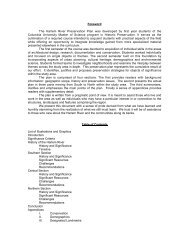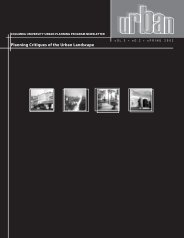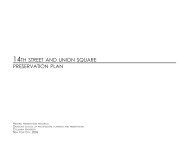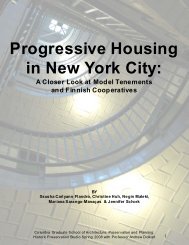The Art of Planning - Columbia University Graduate School of ...
The Art of Planning - Columbia University Graduate School of ...
The Art of Planning - Columbia University Graduate School of ...
You also want an ePaper? Increase the reach of your titles
YUMPU automatically turns print PDFs into web optimized ePapers that Google loves.
24<br />
<strong>The</strong> “scope <strong>of</strong> contracts” include the shiny mosaic installations along the 1 train that<br />
tell a mis-history <strong>of</strong> this City and its people. At Christopher Street-Sheridan Square,<br />
mosaics depict vignettes <strong>of</strong> the community by dividing people into four groupings;<br />
Founders, Providers, Bohemians, and Rebels. <strong>The</strong>se groupings are meant to illustrate the<br />
“identities” <strong>of</strong> Greenwich Village, yet this categorical classification is a harsh contrast to<br />
the community’s history <strong>of</strong> collective mobilization for social change. What happened to the<br />
story about a community that was born in the spirit <strong>of</strong> collective action, and who authorized<br />
this particular telling <strong>of</strong> the story?<br />
Photograph by Jezra Thompson<br />
<strong>of</strong> barbed wire where no one ever seems to sit. <strong>The</strong>re are <strong>of</strong> course challenges that<br />
come with introducing art into a public space. <strong>The</strong> piece must be in<strong>of</strong>fensive, the material<br />
durable, and its presence subtle enough that it doesn’t inhibit the functions <strong>of</strong> the space.<br />
Yet, there exists a marked difference between in<strong>of</strong>fensive and interesting, between uninflammatory<br />
and relative. If people are unable to connect with the art right in front <strong>of</strong><br />
them—the de-contextualized poem, the isolated chair—how much <strong>of</strong> a public purpose is<br />
it really serving?<br />
In his text, <strong>Art</strong>, Space and the City, Malcolm Miles writes, “the use <strong>of</strong> culture as a means<br />
<strong>of</strong> preserving social order is stated as a general characteristic <strong>of</strong> bourgeois society…<br />
it displaces value into an aesthetic domain, setting up a duality <strong>of</strong> art and life, allowing<br />
the impact <strong>of</strong> power or money on everyday life to be unquestioned, or at least less<br />
questioned.” 2<br />
<strong>The</strong> MTA has set-up artistic forums completely disengaged from their urban context. <strong>The</strong><br />
Authority, as they refer to themselves, has created art with rules:<br />
“No person shall destroy, mark, soil or paint, or draw, inscribe,<br />
write, spray paint or place graffiti upon, or remove, injure or<br />
tamper with any facility, conveyance, sign, advertisement,<br />
notice or other property <strong>of</strong> the Authority, or attempt to commit<br />
any <strong>of</strong> the aforementioned acts, except that this subdivision<br />
shall not apply to any work within the scope <strong>of</strong> any contract<br />
made by or on behalf <strong>of</strong> the Authority.” 3<br />
<strong>The</strong> ‘authority’ forgets that much <strong>of</strong> American graffiti was born in New York. In the 1970s<br />
and 1980s, subways cars became mobile canvasses, the ultimate symbol <strong>of</strong> the urban<br />
frontier – this was the art. And yet, while the subway became an artistic forum, ridership fell<br />
to all-time lows. <strong>The</strong> use <strong>of</strong> the space as a canvas meant the loss <strong>of</strong> its functionality; people<br />
could no longer comfortably use it as transportation. Public art can become disengaging if<br />
it alienates people from using a space for its intended function. When the subway became<br />
an unchecked public art forum, a public message that the MTA had lost control <strong>of</strong> (or<br />
at least jurisdiction over) the use <strong>of</strong> the subway as a transit system became apparent.<br />
<strong>The</strong> subway clean-up <strong>of</strong> the late 1980s and early 1990s, during which every mural was<br />
whitewashed over, was the MTA’s way <strong>of</strong> reclaiming the space.<br />
Today, musicians cannot even play in subway stations without being harassed by<br />
authorities. Gone are the days <strong>of</strong> artistic spontaneity, they have been confined to the<br />
margins <strong>of</strong> the space they occupy – under a bright yellow MTA issued banner crediting<br />
“Music Under New York” (An <strong>Art</strong>s For Transit Program).<br />
<strong>The</strong> art in the subway is now commissioned by the capital stakeholders <strong>of</strong> the space.<br />
Images and ideas previously concocted by subway riders have been discarded in<br />
the interest <strong>of</strong> making a sale, <strong>of</strong> “showing respect for our customers and enhancing<br />
the experience <strong>of</strong> travel.” What is this art representing? Not the people from the<br />
neighborhoods where these installations are made, or the cultures <strong>of</strong> the local<br />
communities where these musicians are beckoned to play. This is not locally grown art,<br />
but a series <strong>of</strong> inseminated cultural ideals, manufactured by a consumer agenda.<br />
REFERENCES<br />
1<br />
Smith, Neil, and Deborah Cowen, “Suburban Manhattan”. <strong>The</strong> Suburbanization <strong>of</strong> New York. New York:<br />
Princeton Architectural Press, 2007.<br />
2<br />
Miles, Malcolm. <strong>Art</strong>, Space, and the City: Public <strong>Art</strong> and Urban Futures. New York: Routledge, 1997. (58)<br />
3<br />
New York City Transit/ Metropolitan Transit Authority. “Property and Equipment.” Rules For Conduct. Online:<br />
http://mta.info/nyct/rules/rules.htm. (Section 1050.5)<br />
URBAN
















